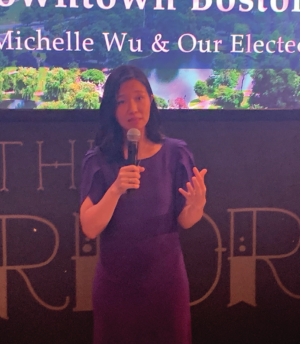Affordability was first and foremost in a recent discussion of issues facing the Downtown, with a 200-foot high cutout in PLAN: Downtown’s new zoning a close second.
Mayor Michelle Wu outlined her perspective on the Downtown at a September 19 meeting of the newly christened Downtown Boston Neighborhood Association (DBNA), alongside a host of city councilors and state representatives all concerned about Boston’s ongoing cost of living crisis.
Several councilors from all sides of the political spectrum said their top priority was getting Boston’s housing market back on track, with the goal of ensuring that neighborhoods like the Downtown aren’t the exclusive purview of the wealthy.
Mayor Wu highlighted the possibility of office conversions, an option the city has been exploring alongside the PLAN: Downtown zoning analysis. While not all of the vacant offices hollowed out by the pandemic can be renovated into housing, the city is offering financial assistance to those that can.
Wu also said the city is currently looking at a more direct approach, cataloging vacant city-owned plots of land and trying to find paths for developers to build housing on them. While specific details and timelines weren’t something she offered at this point, she did say their audit had identified around 150 potential parcels.
“Housing is the make or break for Boston,” she said. “We’re putting every dollar we can toward affordability and supply, and making sure that the city’s growth is actually in the types of housing we need.”
State Representative Aaron Michlewitz said the state was considering similar action, with new Governor Maura Healey putting her thumb on the scale to make housing affordability a more competitive priority relative to the state’s obligation to get maximum value out of taxpayer properties.
One more specific issue also took top billing,a 400-foot height cutout from Court Street to Bromfield baked into the current draft zoning of PLAN: Downtown. For comparison, the rest of the “enhancement area” in the Ladder Blocks has a height limit of 155 or 180 feet.
Opposition from residents was widespread and organized enough that advocates had crafted pins for those against the cutout to wear. They accused planners of setting the height specifically for an unnamed developer to build under, an example of the kind of spot zoning that PLAN: Downtown is supposed to do away with.
“We were so excited about your election because you pledged community driven planning, which we love and believe in,” said Kim Trask, a 35-year resident of the neighborhood vocal on planning issues. “Community consensus formed over years of work on PLAN: Downtown. Then the pandemic happened, and leadership changed. And the new leader of the BPDA just rejected what the community had come up with and replaced it with that spot zone.”
Mayor Wu said the cutout wasn’t made with any developer in mind.
Any
proposal would still have to go through the normal planning process.
That said, if zoning is actually going to be enforced and officials
don’t want to choke off the city’s growth, areas must be designated
where construction is possible.
“I’ve
gone back and forth with the team a great deal. The plan is not written
to allow for a backdoor deal with any particular developer or project.
That’s exactly what we’re trying to move away from,” she said. “However,
in places where height does make sense, we have to put that
predictability right up front.”
Wu
did agree to meet with cutout opponents for further discussion. She was
among several politicians who offered measured suspicion of any
proposal to build nonresidential projects on the site, wondering whether
the Downtown needs more office space with so much already sitting
vacant.
“If there’s
anywhere in this district where height does make sense, it’s there,” Wu
said. “I personally am skeptical about adding more large-scale
commercial offices in a time when we’re seeing vacancies left and right.
We want to make sure this neighborhood is a thriving, mixed residential
neighborhood.”